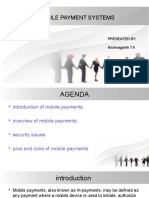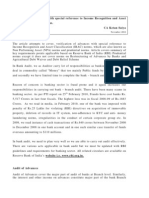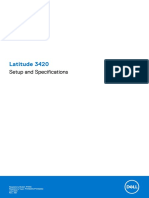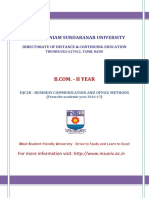Professional Documents
Culture Documents
Fraud Detection in Internet Banking Transactions
Copyright
Available Formats
Share this document
Did you find this document useful?
Is this content inappropriate?
Report this DocumentCopyright:
Available Formats
Fraud Detection in Internet Banking Transactions
Copyright:
Available Formats
Volume 6, Issue 3, March – 2021 International Journal of Innovative Science and Research Technology
ISSN No:-2456-2165
Fraud Detection in Internet Banking Transactions
using Sliding Window Strategy
Abhinandan1,Abhijeet Chauhan2, Divyendu Shekhar3, Narendra Kumar4
1
Computer Science & Engineering, National Institute of Engineering, Mysore
2
Computer Science & Engineering, National Institute of Engineering, Mysore
3
Information Science & Engineering, National Institute of Engineering
4
Computer Science & Engineering, National Institute of Engineering, Mysore
Abstract:- Internet Banking(IB) frauds are relatively transactions done by an accountholder and to simultaneously
eaisier for hackers and attackers with malafide overcome the problem of concept drift. Table 1, shows
intentions and so the number of Internet banking frauds basic attributes that are captured when any financial or non
these days are overwhelming. E-commerce platforms financial transaction is done.
and many other online shopping portals have included
Internet Banking as a payment mode, increasing the risk Table 1: Raw attributes of Internet Banking activities
for IB frauds. The primary intent of this research work FEATURE NAME BRIEF DESCRIPTION
is to improvise and develop a unique and new fraud
identification technique for Internet Banking UTR number Unique Identification
Transactions by analysing the past transaction and Number of a transaction
banking details of the customer and deduce the patterns
in the nature of transactions done so as to be able to Account Number Identifier of a user account
detect an anomalous transaction in future. Where IB Total Amount The total Amount
account holders are grouped into different categories transferred
based on their transaction and internet banking Time Time of the transaction
activites. Then we make use of the sliding window IP IP address of the device
protocol or strategy, to assimilate the transactions and from which transaction is
activities done by the customers from different internet done
banking channels so that the patterns and similarities in Marker or Label To specify whether the
the nature and type of the transactions belonging to transaction is legitimate or
different categories or groups can be inferred and fraudulent
extracted respectively.
2.1. Algorithm
Keywords:- Internet Banking Transactions, Sliding Window
Strategy, Concdept Drift; Firstly, we use a grouping mechanism to categorise the
account holders into different categories or baskets based
I. INTRODUCTION on their transaction volume, i.e., high, medium, and low
using range partitioning technique.
Internet Banking(IB) transactions being the
Using Sliding-Window protocol and strategy, we classify
cornerstone of cashless economy, there is a spike in the
the Internet Banking activities into respective categories,
volume of such transactions. The statistics available with
i.e., extract features from the sliding window to find the
National Crime Records Bureau says that in excess of three
user’s behavioural patterns. Features like Geo-location
thousand incidences of internet banking frauds were
(IP range), max amount, min amount of transaction, in
recorded in 2018. Internet banking data is highly
the window and even the time taken in the process.
disproportionate because there will often be more number of
legitimate transactions when compared with fraudulent
Algorithm 1: Algorithm to classify and group transaction
transactions. However, despite all adversaries, there are
details and to deducecustomerbehaviors using sliding
umpteen strategies and techniques to overcome this
window technique.
problem.
II. PROPOSED METHOD
Input: account details of the customer, a sequence of
transactions s and window size z.
Internet Banking (IB) activities including financial and
Output: Classified transaction details and behaviors of
non financial transactions are mostly unfamiliar when
account holder legitimate or fraudulent.
studied and compared to past records of the customer. The
main aim of our research work is to device a method or
algorithm to predict the legitimacy of the new IB
IJISRT21MAR446 www.ijisrt.com 1206
Volume 6, Issue 3, March – 2021 International Journal of Innovative Science and Research Technology
ISSN No:-2456-2165
runtime updations and changes in parameters and features
lead the system or our algorithm to adapt to new
accountholder's behavioural patterns punctualy and timely.
d: length of S
Legitimate= []; Going forward, whenever a new transaction is being
Fraudulent= []; done from the account of a particular accountholder, we can
For g in range 0 to d-z+1: see if the behavior of the transaction matches the behavior of
S: []; the accountholder. If the behavior is new or doubtful, we
may use multifactor authentication to validate the legitimacy
/* sliding window attributes*/
of the transaction before its execution and hense prevent
For j in range g+z-1: potential frauds.
/*Add the transaction to window */
S=S+sj (id); REFERENCES
End
/* behavior extraction related to amount of [1]. http://www.rbi.org.in/Circular/CreditCard
[2]. https://www.kaggle.com/mlg-ulb/creditcardfraud
the transaction*/ [3]. https://www.kaggle.com/uciml/default-of-credit-card-
bi1=MAX_AMT(Sg); clients-dataset
bi2=MIN_AMT(Sg); [4]. https://www.npci.org.in
bi3=AVG_AMT(Sg); [5]. http://www.niti.gov.in
bi4=AMT(Sg); [6]. https://finmin.nic.in
For j in range i+z-1:
/* Time taken for the transaction*/
xi= Time(sj)-Time(sj-1)
End
Pi= (bg1, bg2,bg3,bg4,bg5,);
Q= LABEL(Sg);
/* grouping a transaction into fraudulent
or legitimate */
if Qg=0 then
Legitimate =
(Legitimate)Union(Pg);
Else
Fraudulent
=(Fraudulent)Union(Pg);
End
Anytime a new activity or transaction is fed into the
sliding window, the previous ones are removed and step-
2 is re-executed for each category and group of
transactions.
After generating the score, we turn on an assessment
system, wherein the current activities and updated scores
are fed back to the system for subsequent study and
comparisions.
III. CONCLUSION
In this research work we deviced a new approach and
strategy for fraud identification and prevention in Internet
banking transactions, where customers’ data is grouped on
the basis of their financial and non financial activities in
internet banking channels and we extract behavioural
patterns to dynamically build and incrementally develop a
user profile for each and every accountholder or user. These
IJISRT21MAR446 www.ijisrt.com 1207
You might also like
- Zeeshan Imp UpdatedDocument362 pagesZeeshan Imp UpdatedRishi KalevarNo ratings yet
- Addedum AmexDocument12 pagesAddedum AmexOMOLAYONo ratings yet
- ISTQB Certified Tester Foundation Level: - Module 4 of 6: Test Design TechniquesDocument81 pagesISTQB Certified Tester Foundation Level: - Module 4 of 6: Test Design TechniquesSantosh Rathod100% (1)
- Oakland14chipandskim PDFDocument16 pagesOakland14chipandskim PDFAm RaiNo ratings yet
- Electronic Payment System: Presented byDocument43 pagesElectronic Payment System: Presented bysheetal28svNo ratings yet
- Secure Electronic Transaction (Set Protocol) : Yang Li & Yun WangDocument16 pagesSecure Electronic Transaction (Set Protocol) : Yang Li & Yun Wangsharma@delhiNo ratings yet
- Online Loan Management SystemDocument5 pagesOnline Loan Management SystemGoogle WebNo ratings yet
- Cases of Computer FraudDocument3 pagesCases of Computer FraudAnthony FloresNo ratings yet
- UNIT 4 - Computer Crime: Omputer Heft Nauthorised SE Ccess Odification HE Omputer Isuse CTDocument9 pagesUNIT 4 - Computer Crime: Omputer Heft Nauthorised SE Ccess Odification HE Omputer Isuse CTvicrattlehead2013No ratings yet
- Mobilepayments3 150326043742 Conversion Gate01Document25 pagesMobilepayments3 150326043742 Conversion Gate01Sajjad AhmadNo ratings yet
- Online BankingDocument66 pagesOnline BankingSatyam JaniNo ratings yet
- Cash Handling PowerpointDocument27 pagesCash Handling Powerpointxacrilege100% (1)
- ClonningDocument17 pagesClonningElizabeth MlelwaNo ratings yet
- Manual BluegriffonDocument49 pagesManual BluegriffonestudiocodecNo ratings yet
- Online Banking System in BangladeshDocument88 pagesOnline Banking System in Bangladeshazad121No ratings yet
- Mobile Payment Systems SeminarDocument26 pagesMobile Payment Systems Seminarkrishnaganth kichaaNo ratings yet
- ATM Reporting SystemDocument3 pagesATM Reporting SystemSrikanth Jalam80% (5)
- Computer Integrated Manufacturing: Department of Industrial & Systems EngineeringDocument57 pagesComputer Integrated Manufacturing: Department of Industrial & Systems Engineeringkpk1989No ratings yet
- Verification of advances and NPA norms under RBI guidelinesDocument12 pagesVerification of advances and NPA norms under RBI guidelinesAvinash SinyalNo ratings yet
- Mobile PaymentsDocument36 pagesMobile Paymentsadnan67No ratings yet
- Hackingpointofsale 140715151838 Phpapp01Document43 pagesHackingpointofsale 140715151838 Phpapp01Thuy VuNo ratings yet
- Internet Banking PDFDocument19 pagesInternet Banking PDFJadhav NikitaNo ratings yet
- Digital Account Opening - 20190604Document14 pagesDigital Account Opening - 20190604Davies Wright LtdNo ratings yet
- The Pros and Cons of Internet Banking A Short Revi PDFDocument11 pagesThe Pros and Cons of Internet Banking A Short Revi PDFMelati SiregarNo ratings yet
- Murali Resume TestingDocument3 pagesMurali Resume TestingBhanu Prasad100% (1)
- Innovations of ATM Banking Services and Upcoming Challenges: Bangladesh PerspectiveDocument67 pagesInnovations of ATM Banking Services and Upcoming Challenges: Bangladesh PerspectiveRahu RayhanNo ratings yet
- Project Net BankingDocument37 pagesProject Net Bankingsamrat1988100% (1)
- Credit CardDocument6 pagesCredit Cardredwanur_rahman2002No ratings yet
- Eastern Bank Ltd. - Visa Corporate Platinum Credit CardDocument5 pagesEastern Bank Ltd. - Visa Corporate Platinum Credit CardJubayer BhuiyanNo ratings yet
- Union Bank Ppt46454Document18 pagesUnion Bank Ppt46454Komal Jain0% (1)
- E-Commerce Project Report InsightsDocument25 pagesE-Commerce Project Report InsightsPriya Pathariya0% (1)
- Prepaid Cards For Transit Agencies 20110212Document38 pagesPrepaid Cards For Transit Agencies 20110212amolnatuNo ratings yet
- Yes Bank (Case)Document6 pagesYes Bank (Case)naviiiiiNo ratings yet
- Online Transaction Fraud Detection Using Python & Backlogging On E-CommerceDocument6 pagesOnline Transaction Fraud Detection Using Python & Backlogging On E-CommerceThe Futura LabsNo ratings yet
- Improving Security Challeges of Atm System in Commercial Bank of Ethiopia: The Case of Wolaita Zone, Sodo CityDocument21 pagesImproving Security Challeges of Atm System in Commercial Bank of Ethiopia: The Case of Wolaita Zone, Sodo CityInternational Journal of Application or Innovation in Engineering & ManagementNo ratings yet
- HDFC Annual Report 2010 11Document156 pagesHDFC Annual Report 2010 11Niranjan PrasadNo ratings yet
- 5 6059900569177293719Document76 pages5 6059900569177293719chinna ladduNo ratings yet
- PhishingDocument15 pagesPhishingchahakan jainNo ratings yet
- Controlling Credit Card FraudDocument4 pagesControlling Credit Card Fraudbalaji bysaniNo ratings yet
- Mechanised Cheque Processing GuidelinesDocument29 pagesMechanised Cheque Processing Guidelinesmantyame100% (1)
- Flip CartDocument57 pagesFlip CartsanthoshNo ratings yet
- R. K. Desai Achchhariwala College of Computer and Applied ScienceDocument29 pagesR. K. Desai Achchhariwala College of Computer and Applied ScienceKhushboo Kirtikumar DesaiNo ratings yet
- Mobile BankingDocument47 pagesMobile BankingMuzany Suradi100% (2)
- Plastic MoneyDocument40 pagesPlastic Moneytotalpalu33% (3)
- Uml (Atm)Document29 pagesUml (Atm)Henu Sharma100% (1)
- Debit Card Fraud Detection Using HMMDocument3 pagesDebit Card Fraud Detection Using HMMAmir AmirthalingamNo ratings yet
- Money Pad, The Future Wallet: Welcome To The SeminarDocument19 pagesMoney Pad, The Future Wallet: Welcome To The SeminarBunny PreethamNo ratings yet
- Innovative Electronic Cash Transfer Programme For Emergencies: An Oxfam-Visa Case Study in The PhilippinesDocument20 pagesInnovative Electronic Cash Transfer Programme For Emergencies: An Oxfam-Visa Case Study in The PhilippinesOxfamNo ratings yet
- Resume of A - GT - 5Document2 pagesResume of A - GT - 5api-29763848No ratings yet
- Money PadDocument15 pagesMoney PadSubhash PbsNo ratings yet
- The Magic PassportDocument7 pagesThe Magic Passportmarcelo cobiasNo ratings yet
- Axis Bank Debit and Credit Card SonamDocument81 pagesAxis Bank Debit and Credit Card SonamsonamNo ratings yet
- Credit Card Lab Math 1050Document2 pagesCredit Card Lab Math 1050api-574894346No ratings yet
- Biometrics in Secure E-TransactionDocument4 pagesBiometrics in Secure E-TransactionREx Ethics100% (1)
- Bank details with account numbers and PANDocument2 pagesBank details with account numbers and PANsuneethaNo ratings yet
- Jamuna Bank Admit CardDocument1 pageJamuna Bank Admit CardSaima AbedinNo ratings yet
- White Paper: Case Study: The Home Depot Data BreachDocument19 pagesWhite Paper: Case Study: The Home Depot Data BreachDiksha PanditNo ratings yet
- Money PadDocument20 pagesMoney PadRahul PurohitNo ratings yet
- Predicting Personal Loan Approval Using Machine Learning HandbookDocument31 pagesPredicting Personal Loan Approval Using Machine Learning HandbookEzhilarasiNo ratings yet
- On-Line Payment System Survey - EcashDocument9 pagesOn-Line Payment System Survey - EcashJournal of Mobile, Embedded and Distributed Systems (JMEDS)No ratings yet
- Current Statistics: EPW Research FoundationDocument1 pageCurrent Statistics: EPW Research FoundationshefalijnNo ratings yet
- CCPSPJan 2017Document3 pagesCCPSPJan 2017aNo ratings yet
- An Analysis on Mental Health Issues among IndividualsDocument6 pagesAn Analysis on Mental Health Issues among IndividualsInternational Journal of Innovative Science and Research TechnologyNo ratings yet
- Harnessing Open Innovation for Translating Global Languages into Indian LanuagesDocument7 pagesHarnessing Open Innovation for Translating Global Languages into Indian LanuagesInternational Journal of Innovative Science and Research TechnologyNo ratings yet
- Diabetic Retinopathy Stage Detection Using CNN and Inception V3Document9 pagesDiabetic Retinopathy Stage Detection Using CNN and Inception V3International Journal of Innovative Science and Research TechnologyNo ratings yet
- Investigating Factors Influencing Employee Absenteeism: A Case Study of Secondary Schools in MuscatDocument16 pagesInvestigating Factors Influencing Employee Absenteeism: A Case Study of Secondary Schools in MuscatInternational Journal of Innovative Science and Research TechnologyNo ratings yet
- Exploring the Molecular Docking Interactions between the Polyherbal Formulation Ibadhychooranam and Human Aldose Reductase Enzyme as a Novel Approach for Investigating its Potential Efficacy in Management of CataractDocument7 pagesExploring the Molecular Docking Interactions between the Polyherbal Formulation Ibadhychooranam and Human Aldose Reductase Enzyme as a Novel Approach for Investigating its Potential Efficacy in Management of CataractInternational Journal of Innovative Science and Research TechnologyNo ratings yet
- The Making of Object Recognition Eyeglasses for the Visually Impaired using Image AIDocument6 pagesThe Making of Object Recognition Eyeglasses for the Visually Impaired using Image AIInternational Journal of Innovative Science and Research TechnologyNo ratings yet
- The Relationship between Teacher Reflective Practice and Students Engagement in the Public Elementary SchoolDocument31 pagesThe Relationship between Teacher Reflective Practice and Students Engagement in the Public Elementary SchoolInternational Journal of Innovative Science and Research TechnologyNo ratings yet
- Dense Wavelength Division Multiplexing (DWDM) in IT Networks: A Leap Beyond Synchronous Digital Hierarchy (SDH)Document2 pagesDense Wavelength Division Multiplexing (DWDM) in IT Networks: A Leap Beyond Synchronous Digital Hierarchy (SDH)International Journal of Innovative Science and Research TechnologyNo ratings yet
- Comparatively Design and Analyze Elevated Rectangular Water Reservoir with and without Bracing for Different Stagging HeightDocument4 pagesComparatively Design and Analyze Elevated Rectangular Water Reservoir with and without Bracing for Different Stagging HeightInternational Journal of Innovative Science and Research TechnologyNo ratings yet
- The Impact of Digital Marketing Dimensions on Customer SatisfactionDocument6 pagesThe Impact of Digital Marketing Dimensions on Customer SatisfactionInternational Journal of Innovative Science and Research TechnologyNo ratings yet
- Electro-Optics Properties of Intact Cocoa Beans based on Near Infrared TechnologyDocument7 pagesElectro-Optics Properties of Intact Cocoa Beans based on Near Infrared TechnologyInternational Journal of Innovative Science and Research TechnologyNo ratings yet
- Formulation and Evaluation of Poly Herbal Body ScrubDocument6 pagesFormulation and Evaluation of Poly Herbal Body ScrubInternational Journal of Innovative Science and Research TechnologyNo ratings yet
- Advancing Healthcare Predictions: Harnessing Machine Learning for Accurate Health Index PrognosisDocument8 pagesAdvancing Healthcare Predictions: Harnessing Machine Learning for Accurate Health Index PrognosisInternational Journal of Innovative Science and Research TechnologyNo ratings yet
- The Utilization of Date Palm (Phoenix dactylifera) Leaf Fiber as a Main Component in Making an Improvised Water FilterDocument11 pagesThe Utilization of Date Palm (Phoenix dactylifera) Leaf Fiber as a Main Component in Making an Improvised Water FilterInternational Journal of Innovative Science and Research TechnologyNo ratings yet
- Cyberbullying: Legal and Ethical Implications, Challenges and Opportunities for Policy DevelopmentDocument7 pagesCyberbullying: Legal and Ethical Implications, Challenges and Opportunities for Policy DevelopmentInternational Journal of Innovative Science and Research TechnologyNo ratings yet
- Auto Encoder Driven Hybrid Pipelines for Image Deblurring using NAFNETDocument6 pagesAuto Encoder Driven Hybrid Pipelines for Image Deblurring using NAFNETInternational Journal of Innovative Science and Research TechnologyNo ratings yet
- Terracing as an Old-Style Scheme of Soil Water Preservation in Djingliya-Mandara Mountains- CameroonDocument14 pagesTerracing as an Old-Style Scheme of Soil Water Preservation in Djingliya-Mandara Mountains- CameroonInternational Journal of Innovative Science and Research TechnologyNo ratings yet
- A Survey of the Plastic Waste used in Paving BlocksDocument4 pagesA Survey of the Plastic Waste used in Paving BlocksInternational Journal of Innovative Science and Research TechnologyNo ratings yet
- Hepatic Portovenous Gas in a Young MaleDocument2 pagesHepatic Portovenous Gas in a Young MaleInternational Journal of Innovative Science and Research TechnologyNo ratings yet
- Design, Development and Evaluation of Methi-Shikakai Herbal ShampooDocument8 pagesDesign, Development and Evaluation of Methi-Shikakai Herbal ShampooInternational Journal of Innovative Science and Research Technology100% (3)
- Explorning the Role of Machine Learning in Enhancing Cloud SecurityDocument5 pagesExplorning the Role of Machine Learning in Enhancing Cloud SecurityInternational Journal of Innovative Science and Research TechnologyNo ratings yet
- A Review: Pink Eye Outbreak in IndiaDocument3 pagesA Review: Pink Eye Outbreak in IndiaInternational Journal of Innovative Science and Research TechnologyNo ratings yet
- Automatic Power Factor ControllerDocument4 pagesAutomatic Power Factor ControllerInternational Journal of Innovative Science and Research TechnologyNo ratings yet
- Review of Biomechanics in Footwear Design and Development: An Exploration of Key Concepts and InnovationsDocument5 pagesReview of Biomechanics in Footwear Design and Development: An Exploration of Key Concepts and InnovationsInternational Journal of Innovative Science and Research TechnologyNo ratings yet
- Mobile Distractions among Adolescents: Impact on Learning in the Aftermath of COVID-19 in IndiaDocument2 pagesMobile Distractions among Adolescents: Impact on Learning in the Aftermath of COVID-19 in IndiaInternational Journal of Innovative Science and Research TechnologyNo ratings yet
- Studying the Situation and Proposing Some Basic Solutions to Improve Psychological Harmony Between Managerial Staff and Students of Medical Universities in Hanoi AreaDocument5 pagesStudying the Situation and Proposing Some Basic Solutions to Improve Psychological Harmony Between Managerial Staff and Students of Medical Universities in Hanoi AreaInternational Journal of Innovative Science and Research TechnologyNo ratings yet
- Navigating Digitalization: AHP Insights for SMEs' Strategic TransformationDocument11 pagesNavigating Digitalization: AHP Insights for SMEs' Strategic TransformationInternational Journal of Innovative Science and Research Technology100% (1)
- Drug Dosage Control System Using Reinforcement LearningDocument8 pagesDrug Dosage Control System Using Reinforcement LearningInternational Journal of Innovative Science and Research TechnologyNo ratings yet
- The Effect of Time Variables as Predictors of Senior Secondary School Students' Mathematical Performance Department of Mathematics Education Freetown PolytechnicDocument7 pagesThe Effect of Time Variables as Predictors of Senior Secondary School Students' Mathematical Performance Department of Mathematics Education Freetown PolytechnicInternational Journal of Innovative Science and Research TechnologyNo ratings yet
- Formation of New Technology in Automated Highway System in Peripheral HighwayDocument6 pagesFormation of New Technology in Automated Highway System in Peripheral HighwayInternational Journal of Innovative Science and Research TechnologyNo ratings yet
- Course Name: IAA202 Student Name: Chế Công Đại: Risk planning Risk identificationDocument3 pagesCourse Name: IAA202 Student Name: Chế Công Đại: Risk planning Risk identificationCông ĐạiNo ratings yet
- CMRIT Wireless Cellular and LTE 4G CourseDocument4 pagesCMRIT Wireless Cellular and LTE 4G CourseSanjana AkkoleNo ratings yet
- Nvidia Professional Graphics SolutionsDocument2 pagesNvidia Professional Graphics SolutionsMario BorgiattinoNo ratings yet
- Customer Churn Prediction For Telecom Services: Utku Yabas Hakki Candan Cankaya Turker InceDocument2 pagesCustomer Churn Prediction For Telecom Services: Utku Yabas Hakki Candan Cankaya Turker IncenimaNo ratings yet
- Comp 473 Assignment 1 and 2Document8 pagesComp 473 Assignment 1 and 2Felix GathageNo ratings yet
- Two Scoops of Django 3x - Compress 3Document50 pagesTwo Scoops of Django 3x - Compress 3Can İsildarNo ratings yet
- Lab Risk Analysis Answer KeyDocument10 pagesLab Risk Analysis Answer KeyMarcos SouzaNo ratings yet
- Laptops and PCs from TIENDA LUZ under 40 charactersDocument158 pagesLaptops and PCs from TIENDA LUZ under 40 charactersIgnacio Ocacio CabreraNo ratings yet
- SQL Games We Can Play in PLSQLDocument31 pagesSQL Games We Can Play in PLSQLAshok BabuNo ratings yet
- Ey-H3l Yh1576Document44 pagesEy-H3l Yh1576jorgeNo ratings yet
- NUC11TNK L6 UserGuideDocument17 pagesNUC11TNK L6 UserGuidebubbaNo ratings yet
- IEC Certification Kit Release NotesDocument27 pagesIEC Certification Kit Release NotesJAMER OSWALDO CHALA RAMIREZNo ratings yet
- Latitude 14 3420 LaptopDocument23 pagesLatitude 14 3420 LaptopJenn AlavaNo ratings yet
- Scanner Quickview: Pfu Imaging Solutions Europe Limited Pfu Imaging Solutions GMBHDocument23 pagesScanner Quickview: Pfu Imaging Solutions Europe Limited Pfu Imaging Solutions GMBHgvaxNo ratings yet
- Applied Statistics and The SAS ProgrammingDocument85 pagesApplied Statistics and The SAS Programminganugupta.wj9719100% (1)
- Mathematics Concepts For Computing: Number Base SystemDocument55 pagesMathematics Concepts For Computing: Number Base Systemvln100% (1)
- Tecucc 3000Document449 pagesTecucc 3000Sid Ali Oulad SmaneNo ratings yet
- Example 1: of Expt: 5Document2 pagesExample 1: of Expt: 5Anik MazumderNo ratings yet
- Excel Basics 3: Introduction To Excel 3: Counting & Adding: COUNT, COUNTA, SUM, COUNTIFS, SUMIFS FunctionsDocument16 pagesExcel Basics 3: Introduction To Excel 3: Counting & Adding: COUNT, COUNTA, SUM, COUNTIFS, SUMIFS Functionssam662223No ratings yet
- Difference between Structured and Object-Oriented ProgrammingDocument11 pagesDifference between Structured and Object-Oriented ProgrammingMilraclesNo ratings yet
- Manonmaniam Sundaranar University: For More Information Visit: HTTP://WWW - Msuniv.ac - inDocument218 pagesManonmaniam Sundaranar University: For More Information Visit: HTTP://WWW - Msuniv.ac - inindhumathigNo ratings yet
- Rom Index - Francis G Miles - ML - RRDocument1,114 pagesRom Index - Francis G Miles - ML - RRSergio TulioNo ratings yet
- C Important Questions For PaperDocument112 pagesC Important Questions For PaperAbhishek SinghNo ratings yet
- Uar# 612638 - Soltraqs: System Id / Name: System Description: Requested For: Manager: Access Request TypeDocument2 pagesUar# 612638 - Soltraqs: System Id / Name: System Description: Requested For: Manager: Access Request TypeJose AlvaradoNo ratings yet
- Version 2004 (May 2020 Update) : AndroidDocument4 pagesVersion 2004 (May 2020 Update) : AndroidklNo ratings yet
- 5008CEM DEC 2022 PaperDocument15 pages5008CEM DEC 2022 Paperabdul wahidNo ratings yet























































































































